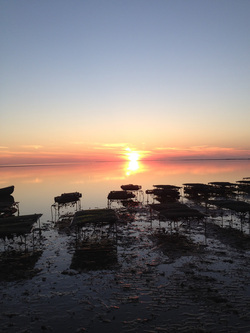 Oyster Beds
Oyster Beds A recent study of the Potamac River by researchers from the National Oceanic and Atmospheric Administration (NOAA) and the U.S. Geological Survey (USGS) used modeling and scientific evaluations to estimate that virtually all nitrogen pollution (leading cause of algae blooms in brackish water such as the Chesapeake Bay) can be eliminated if 40% of the river bed were used for shellfish cultivation. Even using just 15- 25% of the river bed can remove up to 50% of the nutrients.
The nutrients are removed by the filter feeding process of the oysters. The removal of organic particles and nutrients will result in lower nutrient loadings entering the imperiled areas of the Chesapeake Bay. This filtering would also increase dissolved oxygen residuals, reducing the dead zones often seen in polluted waters.

 RSS Feed
RSS Feed